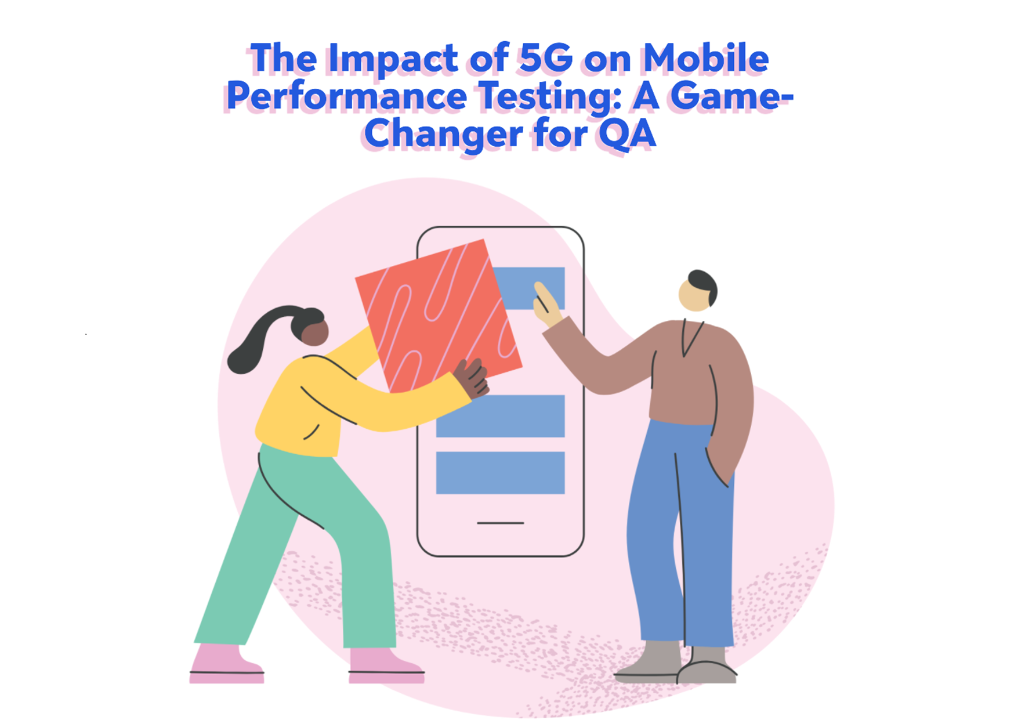 CASE STUDY
CASE STUDY The Impact of 5G on Mobile Performance Testing: A Game-Changer for QA

Introduction: The 5G Revolution in Mobile Testing
The emergence of 5G technology is transforming the mobile landscape, promising ultra-fast data speeds, lower latency, and improved network reliability. This shift significantly impacts how mobile applications are developed, tested, and optimized for performance.
For QA engineers and mobile testers, 5G introduces new challenges and opportunities, requiring updated testing methodologies, performance benchmarks, and optimization techniques. In this discussion, we’ll explore the impact of 5G on mobile performance testing, key areas to focus on, and best practices for ensuring a seamless user experience.
Key Ways 5G is Transforming Mobile Performance Testing
1. Ultra-Fast Speeds & Data Transfer Rates ⚡
Impact on Testing:
- 5G networks offer speeds up to 100x faster than 4G, significantly reducing load times and buffering issues.
- Performance testing must now assess how applications handle high-speed downloads and real-time data processing.
- Applications that rely on large media files, video streaming, or AR/VR experiences need optimized performance testing to match 5G expectations.
Testing Strategy:
✅ Test app performance in high-speed network conditions.
✅ Benchmark download/upload times under 5G connectivity.
✅ Validate large file handling without data corruption.
2. Low Latency for Real-Time Applications ⏳
Impact on Testing:
- 5G significantly reduces network latency to as low as 1 millisecond, improving real-time user interactions.
- Applications for gaming, financial transactions, healthcare (telemedicine), and IoT devices will see enhanced responsiveness.
- QA teams must measure real-time data synchronization, input lag, and network interruptions.
Testing Strategy:
✅ Conduct latency tests for real-time communication apps (video calls, online gaming).
✅ Measure response time in millisecond intervals to ensure seamless user experiences.
✅ Test network jitter and packet loss rates to maintain stability.
3. Increased Network Traffic & Scalability Demands 📶
Impact on Testing:
- More devices will be connected to the 5G network simultaneously, increasing demand on servers and cloud infrastructures.
- Applications must handle higher concurrent user traffic without crashes or slowdowns.
- Scalability testing is crucial to ensure mobile apps remain stable under peak traffic conditions.
Testing Strategy:
✅ Perform load testing and stress testing using tools like JMeter and Gatling.
✅ Simulate high concurrent user sessions to check for server breakdowns.
✅ Monitor backend API performance under heavy network load.
4. Enhanced Mobile Security Challenges 🔐
Impact on Testing:
- 5G opens the door for faster cyberattacks due to increased network accessibility.
- Data encryption, authentication, and privacy measures must be robustly tested.
- Edge computing and distributed data storage add new layers of complexity to security testing.
Testing Strategy:
✅ Perform penetration testing to identify security loopholes.
✅ Validate encryption standards for data transmission over 5G.
✅ Conduct network security audits to protect against DDoS attacks.
5. Impact on Cloud-Based & IoT Applications ☁️📡
Impact on Testing:
- Many mobile applications rely on cloud computing and IoT device connectivity, both of which benefit from 5G’s low latency and fast speeds.
- QA teams must ensure seamless integration between mobile apps, cloud storage, and IoT networks.
- Cross-network compatibility testing becomes essential as devices shift between 5G, 4G, and Wi-Fi networks.
Testing Strategy:
✅ Perform cloud-based performance testing with services like AWS, Azure, or Google Cloud.
✅ Test app behavior when switching between different networks (5G, 4G, Wi-Fi).
✅ Validate data consistency across mobile, cloud, and IoT platforms.
Best Practices for 5G Mobile Performance Testing ✅
To ensure mobile applications perform optimally in the 5G era, follow these best practices:
🔹 Simulate 5G Network Conditions: Use tools like 5G test environments and network throttling to replicate real-world 5G speeds and latencies.
🔹 Optimize for High Bandwidth Usage: Ensure mobile apps compress data efficiently to avoid excessive bandwidth consumption.
🔹 Focus on Edge Computing: Test applications for low-latency processing at the edge of the network instead of relying on centralized data centers.
🔹 Prioritize Security Measures: Implement real-time security testing to identify vulnerabilities that arise with faster data transmission.
🔹 Test for Seamless Device Handover: Validate that applications function smoothly when switching between different networks (5G to 4G, Wi-Fi, etc.).
Conclusion: The Future of Mobile Testing in the 5G Era 🚀
The rollout of 5G technology is a game-changer for mobile applications, offering unprecedented speed, lower latency, and enhanced network reliability. However, with these advancements come new challenges in mobile performance testing.
QA teams must adapt to real-time performance benchmarks, advanced security testing, and cloud-based optimizations to ensure seamless user experiences. By leveraging new testing strategies and best practices, mobile testers can stay ahead in the evolving landscape of 5G-powered applications.
The future of mobile performance testing is here—are you ready to embrace the 5G revolution? 🚀